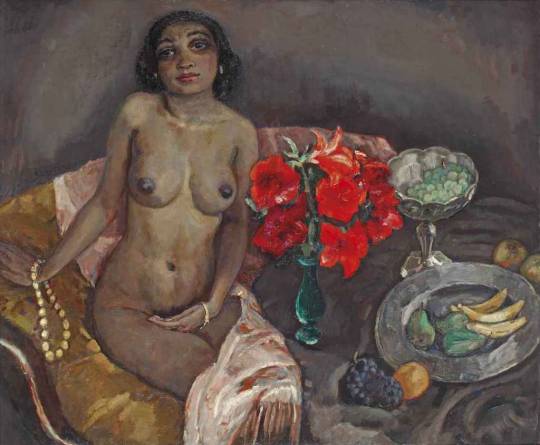Still life was at the bottom of the hierarchy of genres during the renaissance. Artists would sometimes justify a fruit bowl still life through the inclusion of a nude, or by creating visual puns from the symbolism. Some highlighted the erotic associations of certain fruits, with their anthropomorphic shapes. The associations between fruit and sensuality come from the notion of the forbidden fruit, and fruit’s fertile, tactile nature. Like the human figure, fruits were seen as one of God’s creations deserving of representation. Still lifes of fruit bowls could be used to balance out a figure composition and demonstrate the broad range of the artist’s skill in tackling multiple genres in the same work.
Caravaggio was one painter known to use fruits as sexual metaphor. He painted over a dozen pictures containing seventeen different fruits and vegetables. In his ‘Bacchus’ an effeminate young boy with a grapevine in his hair offers out a goblet of red wine. This is quite literal symbolism for Bacchus who was the God of wine, madness and ecstasy. In front of him is a basket of fruit, some ripe and some rotting, leading it to be interpreted as a vanitas – a type of still life common in the renaissance and baroque periods intended to remind the viewer of the fleeting nature of earthly life. Like his figures, Caravaggio painted the fruits from life, including precise representations of disease symptoms and insect damage. One of the vine leaves on his head is turning red, probably an indication of crown gall, a bacterial disease causing swellings on stems and roots. There may be a simpler explanation for the inclusion of rotting fruit, as painting such precise detail would have been a timely process. The fruits include black, red, and white bunches of grapes; a bursting pomegranate, figs, a large green pear, three apples and a half-rotten quince. Whilst some interpret the bursting pomegranate as sexual metaphor, others argue that he was simply displaying his painterly skill, and his love of the shapes and lushness of the fruit.
Any erotic overtones are heightened by Bacchus’ fingering of his loosely draped robe, as he appears to be inviting the viewer to join him with the offer of wine. Upon closer inspection the façade of the Greek God gives way to the reality of a half-drunk teenager with a men’s shirt slung over his shoulder, resting against a grubby mattress in the studio. It has also been discovered that Caravaggio included a miniature self portrait of himself painting his subject in the reflection of the wine glass.
Caravaggio, Bacchus, 1595.
Jan Sluitjers often painted female nudes accompanied by still lifes such as flowers and fruit bowls. These fruit bowls are positioned to the side, in front and behind the model. In both ‘Seated nude with flowers and fruit’ and ‘Still life with standing nude’, the fruit rests on an abundance of crumpled coloured drapes, which continue over the nude’s shoulder and leg, turning her into a part of the still life. Whilst Caravaggio’s ‘Bacchus’ is primarily a painting of the Greek God, adorned by fruit, the fruit and figures in Sluitjers’ paintings are invested with equal significance. It is possible that the artist was drawing parallels between women and fruit, a theory supported by the feminine forms of the various vases and vessels alongside the pears in ‘Still life with standing nude’. The upright vase is a definite echo of the shape of the standing nude, which in turn echoes the pear. Decorative porcelain fruit bowls, as well as the jewellery in ‘Seated nude with flowers and fruits’ suggest the exotic spoils of geographic expansion. Unlike Caravaggio’s fruit, the fruit here all appears to be fresh and ripe, standing as a symbol of female fertility, youth and vitality. However like youthful beauty, we are aware that the fruit is perishable and ephemeral. As the apple is associated with the Tree of Knowledge and the Garden of Eden, the female nude alongside the apple may be a reference to Eve and the notions of temptation and sin.
Jan Sluitjers, Seated Nude with Flowers and Fruits, 1927.
Jan Sluitjers, Still Life with Standing Nude,



